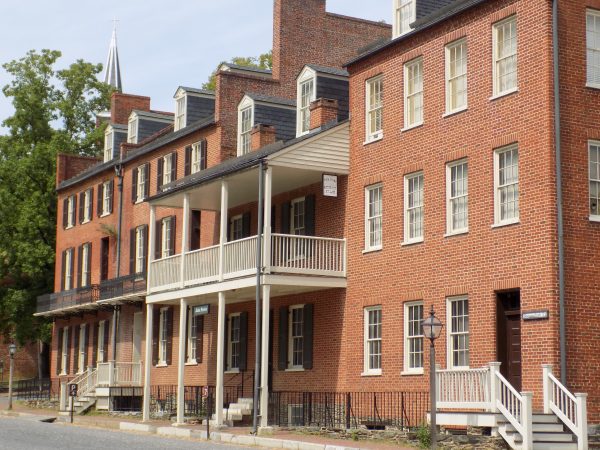ECW Weekender: John Brown Museum in Harpers Ferry
Harpers Ferry National Historical Park offers a plethora of historical narratives through the old buildings, markers, and interpretive tools. From Colonial and Federalist Eras to Lewis and Clark to Civil War and beyond, this historic town offers a lot to explore. And there’s plenty of hiking in the area for the outdoor enthusiast, too. (Just ask Sarah or Chris and Terry…)
John Brown and his fight in the streets of Harpers Ferry is one of the violent pages of the town’s history, and one that must be explored to understand the outbreak of the Civil War (officially two years later). You can explore the sites of the old armory buildings, stand at the site of “John Browns Fort”, see a reconstruction of that engine house, and see parts of the old bridges. But to really explore the history of the fateful days of 1859 and how and why they happened, you’ll want to visit the John Brown Museum.

Located in the historic town near the end of Shenandoah Street and within sight of the rebuilt and relocated Engine House, this museum offers interpretation on the man, 19th Century culture, immediate responses, and memory. Presenting in an overview format, the museum galleries follow Brown’s life through displays, artifacts, interactive opportunities, and short video segments. Information about the other men who accompanied Brown is also available.
 If you’re looking for a “one-stop” to get an overview of John Brown, what better place than this museum in Harpers Ferry. Then, head outside to stand at the sites or watch the river and ponder the mighty questions associated with Brown and the raid.
If you’re looking for a “one-stop” to get an overview of John Brown, what better place than this museum in Harpers Ferry. Then, head outside to stand at the sites or watch the river and ponder the mighty questions associated with Brown and the raid.
Harpers Ferry National Historical Park is offering several special programs this weekend and for the remainder of the month. Be sure to inquire for further details or see if a “spontaneous event” is happening while you’re in town.
Afternoon Tour of the Day – daily until October 31st; 2-3pm; check with the park staff for details and meeting location of the day.
Harpers Ferry: From The Top Down – a 1.5 mile guided hike every Sunday afternoon through October 27th, starting at the Visitor Center at 11:00am.
Archaeology at Harpers Ferry, A History – hosted on Monday, October 21, at 2 pm, in the 2nd floor of the John Brown Museum.
Drink Your Apples: Historic Cider Making – Saturday, October 26th and Sunday, October 27th at White Hall Tavern in the lower town, beginning at 11 am; learn how cider was made!



I have been to Harpers Ferry, and found it very interesting and well worth the time taken to visit. On a related matter I recall reading that some medical college students were on a train passing through Harpers Ferry in the immediate aftermath of the failed raid. The body of one of John Brown’s sons was lying on the nearby street, and the students retrieved his body and took it with them to their college as a lab cadaver. However, I do not recall the source of this information.
Unless one studies in depth the Life of John Brown, it may be wondered: “Where was Brown after he left Kansas, and before he led twenty men against the Arsenal at Harper’s Ferry?” And it may come as a surprise that the answer is Iowa.
Specifically, the Quaker community thirty-five miles west of Davenport, called Springdale. John Brown arrived there before August 1859 and was welcomed into the home of William Maxson. His band conducted military drill and attended daily religious service, and prepared for the coming operation “into the heart of Africa.” And two members of the Springdale community joined with Brown: the Coppoc brothers, Barclay and Edwin.
Edwin Coppoc was captured at Harper’s Ferry and hanged 16 DEC 1859. Barclay Coppoc escaped capture, and managed to return to Iowa. Marshals from Virginia tracked him to Springdale, but his mother refused to accept the warrant from the law enforcement officers; they proceeded to Iowa City and met with Governor Samuel Kirkwood; the governor by his delay permitted Barclay Coppoc to disappear.
With eruption of war at Fort Sumter, Barclay Coppoc reappeared, and gained commission as First Lieutenant in Company C of Colonel Montgomery’s 3rd Kansas Infantry. On September 3rd 1861 Lieutenant Coppoc, returning to his regiment from Salem Ohio, booked passage on the express of the Hannibal & St. Joseph Railroad, westbound, and the train was derailed off a trestle just short of St. Joseph. The rebel sabotage of the express train became known as the Platte River Disaster, and resulted in over one hundred casualties, including 17 deaths. One of those who perished was Lieutenant Coppoc (his death date recorded as September 4th.) Because the train carried not just civilians, but soldiers, it was declared a legitimate military target.